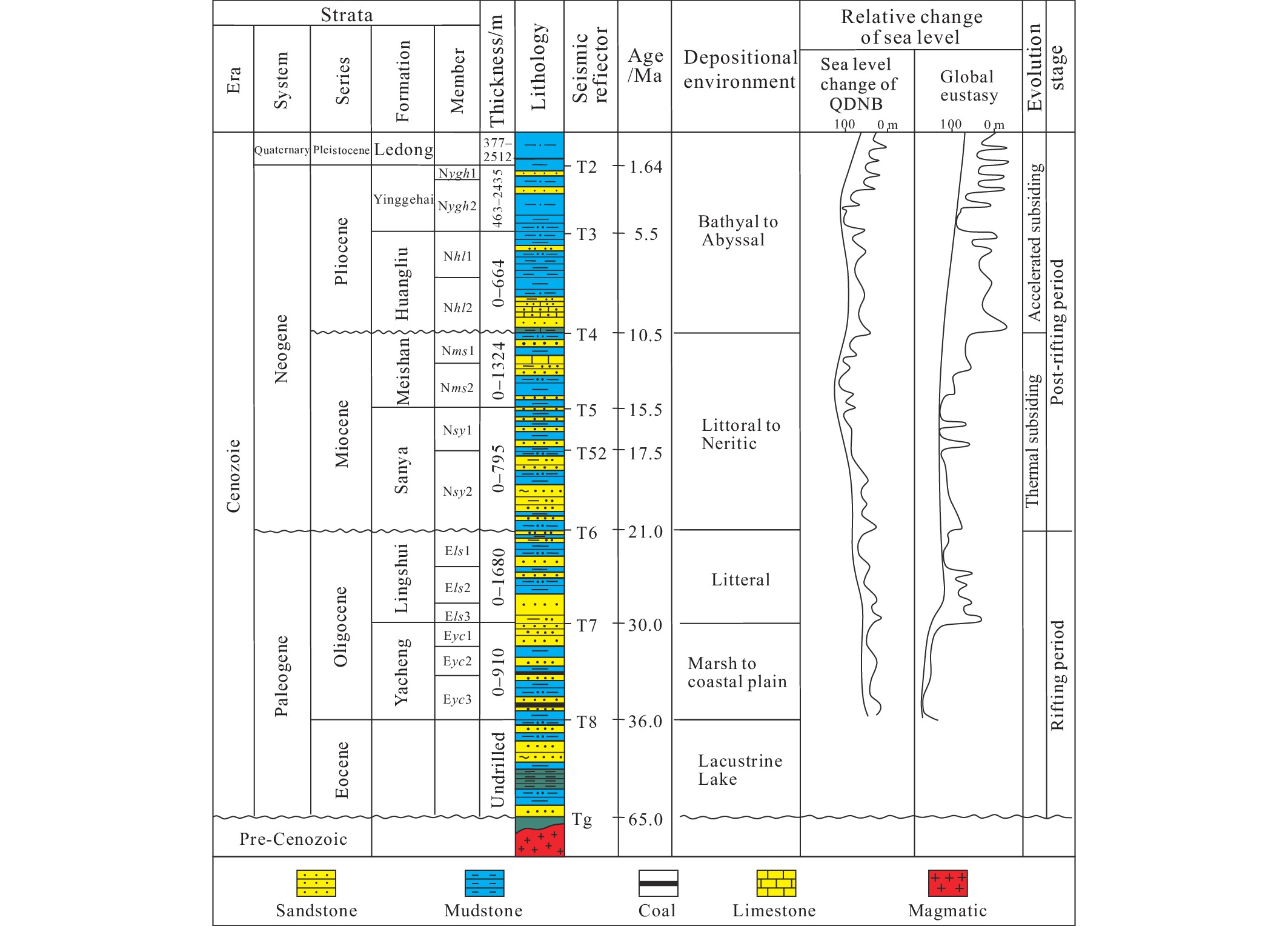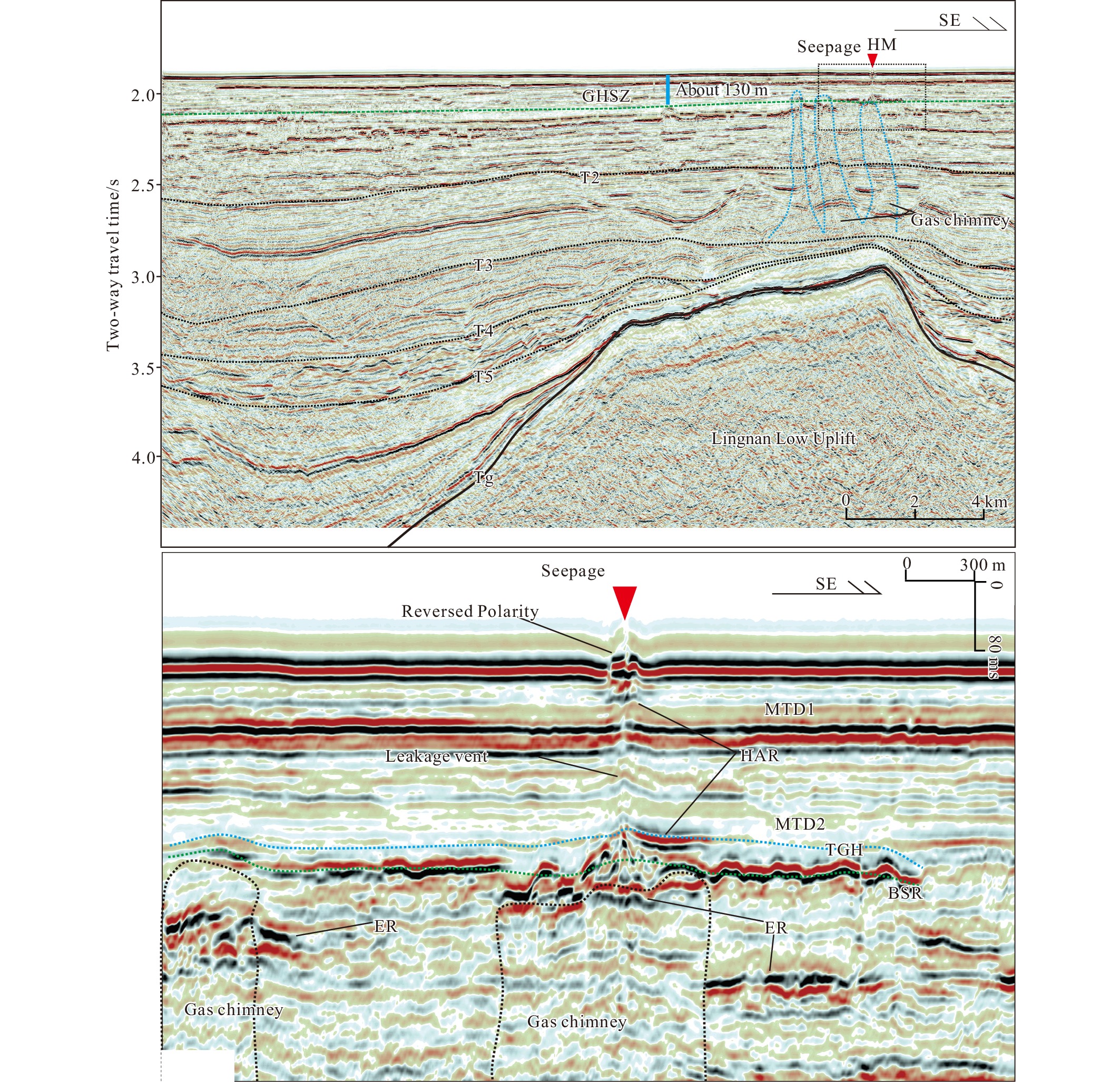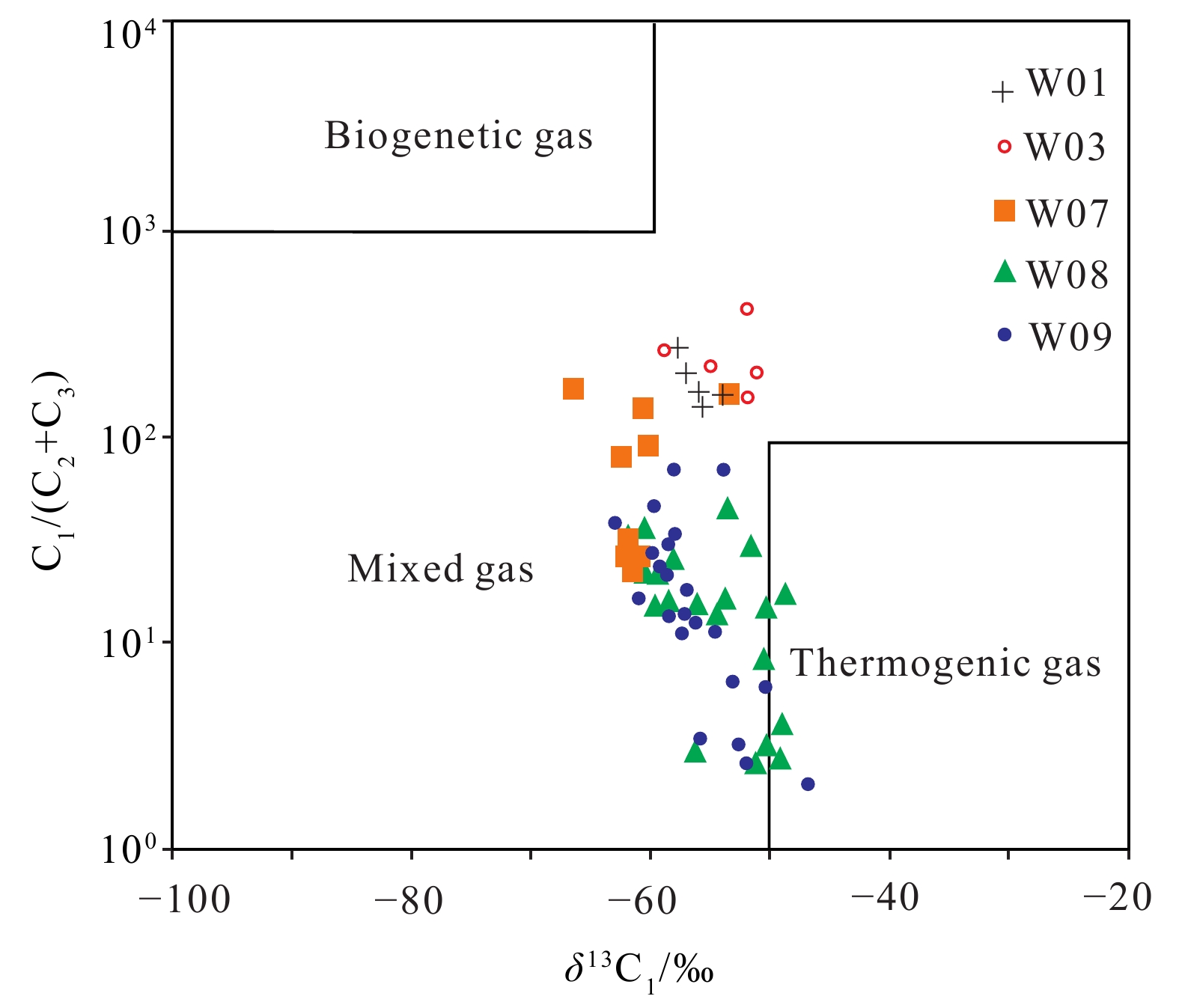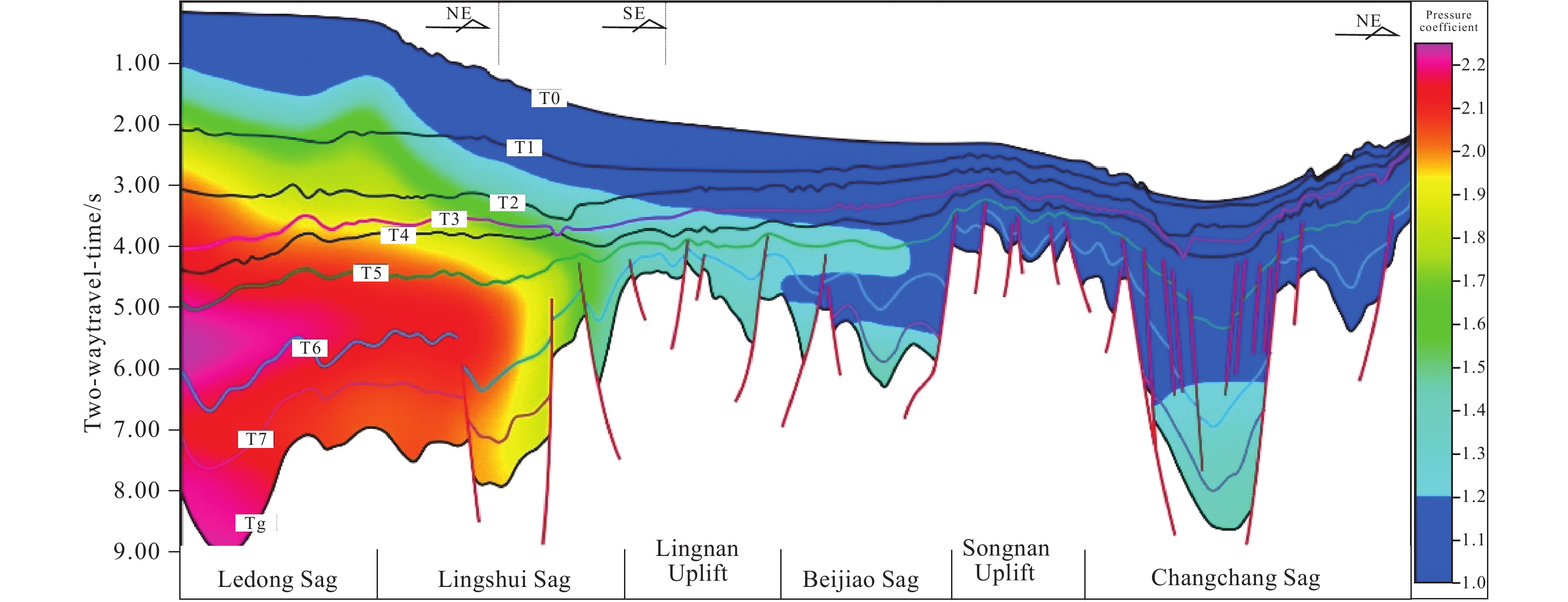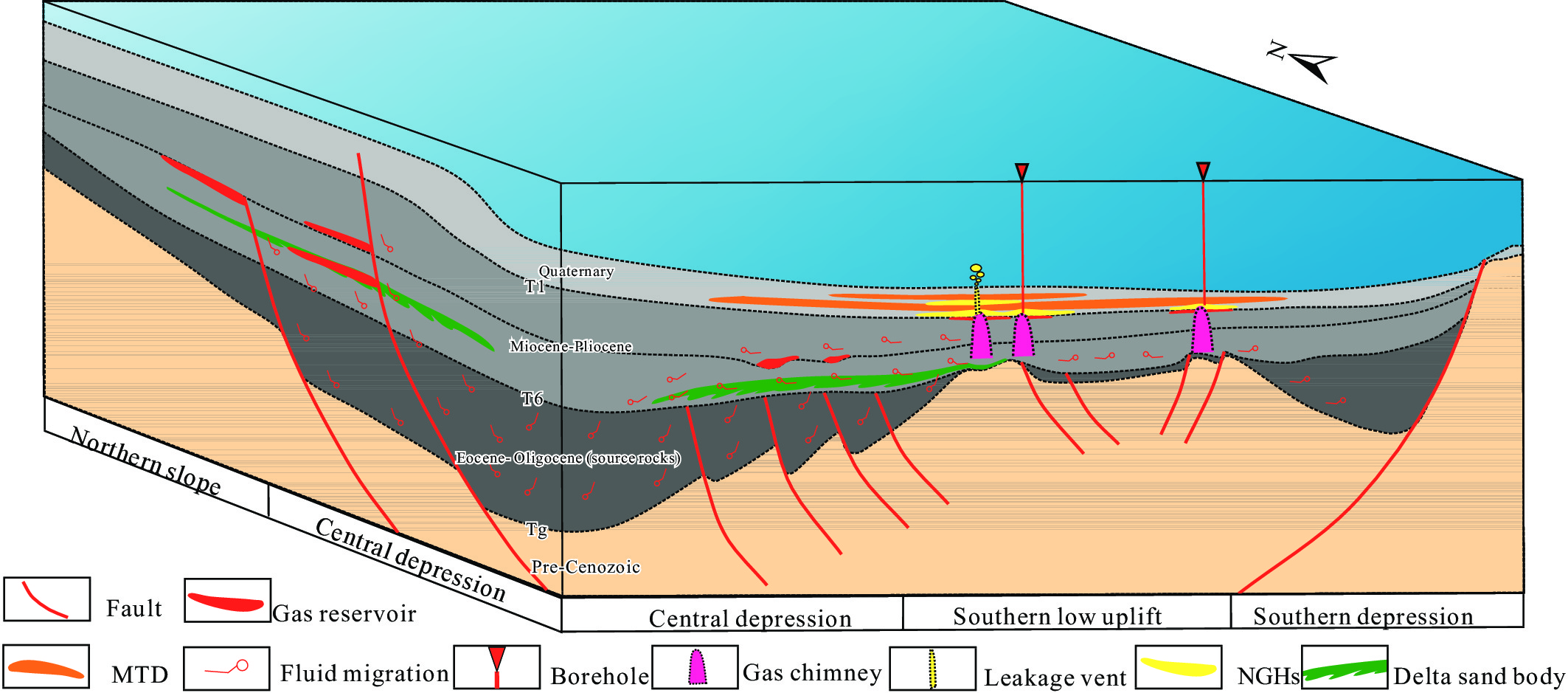| Citation: | Yu-lin He, Jin-qiang Liang, Zeng-gui Kuang, Wei Deng, Jin-feng Ren, Hong-fei Lai, Miao-miao Meng, Wei Zhang, 2022. Migration and accumulation characteristics of natural gas hydrates in the uplifts and their slope zones in the Qiongdongnan Basin, China, China Geology, 5, 234-250. doi: 10.31035/cg2022004 |
Migration and accumulation characteristics of natural gas hydrates in the uplifts and their slope zones in the Qiongdongnan Basin, China
-
Abstract
Various factors controlling the accumulation of natural gas hydrates (NGHs) form various enrichment and accumulation modes through organic combination. This study mainly analyzes the geological and geophysical characteristics of the NGHs occurrence in the uplifts and their slope zones within the deep-water area in the Qiongdongnan (QDN) Basin (also referred to as the study area). Furthermore, it investigates the dominant governing factors and models of NGHs migration and accumulation in the study area. The results are as follows. (1) The uplifts and their slope zones in the study area lie in the dominant pressure-relief direction of fluids in central hydrocarbon-rich sags in the area, which provide sufficient gas sources for the NGHs accumulation and enrichment through pathways such as gas chimneys and faults. (2) The top and flanks of gas chimneys below the bottom simulating reflectors (BSRs) show high-amplitude seismic reflections and pronounced transverse charging of free gas, indicating the occurrence of a large amount of gas accumulation at the heights of the uplifts. (3) Chimneys, faults, and high-porosity and high-permeability strata, which connect the gas hydrate temperature-pressure stability zones (GHSZs) with thermogenic gas and biogenic gas, form the main hydrate migration system. (4) The reservoir system in the study area comprises sedimentary interlayers consisting of mass transport deposits (MTDs) and turbidites. In addition, the reservoir system has developed fissure- and pore-filling types of hydrates in the pathways. The above well-matched controlling factors of hydrate accumulation enable the uplifts and their slope zones in the study area to become the favorable targets of NGHs exploration.
-

-
References
Berndt C. 2005. Focused fluid flow in passive continental margins. Philosophical Transactions of the Royal Society A: Mathematical, Physical and Engineering Sciences, 363(1837), 2855‒2871. doi: 10.1098/rsta.2005.1666. Boswell R, Collett T, Mcconnell D, Frye M, Shedd B, Mrozewski S, Guerin G, Cook A, Godfriaux P, Dufrene R. 2009. Joint industry project Leg II discovers rich gas hydrate accumulations in sand reservoirs in the Gulf of Mexico. Fire in the Ice, 9(3), 1–5. doi: 10.4043/20806‒MS. Chen DF, Huang YY, Yuan XL, Lawrence MC. 2005b. Seep carbonates and Preserved methane oxidizing archaea and sulfate reducing bacteria fossils suggest recent gas venting on the seafloor in the northeastern South China Sea. Marine and Petroleum Geology, 22, 613–621. doi: 10.1016/j.marpetgeo.2005.05.002. Chen DF, Su Z, Feng D, Lawrence M. 2005a. Formation and its controlling factors of gas hydrate reservoir in marine gas vent system. Journal of Tropical Oceanography, 24(3), 38–46. doi: 10.1111/j.1745‒7254.2005.00209.x. Collett TS, Iedel M, Boswell R. 2006. International team completes landmark gas hydrate expedition in the offshore of India. Fire in the Ice, 6(3), 1–4. doi: 10.1016/j.marpetgeo.2014.07.031. Crutchley GJ, Pecher IA, Gorman AR, Greinertde HJ. 2010. Seismic imaging of gas conduits beneath seafloor seep sites in a shallow marine gas hydrate province, Hikurangi Margin, New Zealand. Marine Geology, 272(1), 114–126. doi: 10.1016/j.margeo.2009.03.007. Gay A, Lopez M, Berndt C, Séranneb M. 2009. Geological controls on focused fluid flow associated with seafloor seeps in the Lower Congo Basin. Marine Geology, 244(1‒4), 68‒92. doi: 10.1016/j.margeo.2007.06.003. Haacke RR, Westbrook GK, Hyndman RD, Hyndman RD. 2007. Gas hydrate, fluid flow an free gas: Formation of the bottom‒simulating reflector. Earth & Planetary Science Letters, 261(3‒4), 407‒420. doi: 10.1016/j.jpgl.200707008. He JX, Su PB, Lu ZQ, Zhang W, Liu ZJ, Li XT. 2015. Prediction of gas sources of natural gas hydrate in the Qiongdongnan basin, northern South China Sea, and its migration, accumulation and reservoir formation pattern. Natural Gas Industry, 35(8), 19–29 (in Chinese with English abstract). doi: 10.3787/j.issn.1000‒0976.2015.08.003. Horozal S, Lee GH, Yi BY, Yoo DG, Park KP, Lee HY, Kim W, Kim JK, Lee K. 2009. Seismic indicators of gas hydrate and associated gas in the Ulleung Basin, East Sea (Japan Sea) and implications of heat flows derived from depths of the bottom‒simulating reflector. Marine Geology, 258(1‒4), 126‒138. doi: 10.1016/j.margeo.2008.12.004. Lai HF, Fang YX, Kuang ZG, Ren JF, Liang JQ, Lu JA, Wang G, Xing C. 2021. Geochemistry, origin and accumulation of natural gas hydrates in the Qiongdongnan Basin, South China Sea: Implications from site GMGS5‒W08. Marine and Petroleum Geology, 123, 104774. doi: 10.1016/j.marpetgeo.2020.104774. Lei ZY, Su M, Zhang L, Shuai QW, Sun M, Liu J, Yang R. 2016. Sediment sources and transport patterns of Qiongdongnan Basin in Northern Slope of South China Sea since Late Miocene. Journal of Marine Sciences, 34(2), 35–42 (in Chinese with English abstract). Li C, Ma M, Lü CF, Zhang GC, Chen GJ, Yan YK, Bi GX. 2017. Sedimentary differences between different segments of the continental slope‒parallel central canyon in the Qiongdongnan Basin on the northern margin of the South China Sea. Marine and Petroleum Geology, 88, 127–140. doi: 10.1016/j.marpetgeo.2017.08.009. Li CF, Jian XX, Sun Z, Zhu J, Yao YJ, Zhao XX, Liu QS, Kulhanek DK, Wang J, Song TR, Zhao JF, Qiu N, Guan YX, Zhou ZY, Williams T, Bao R, Briais A, Brown EA, Chen YF, Clift VPD, Colwell FS, Dadd KA, Ding WW, Almeida IH, Huang XL, Hyun S, Jiang T, Koppers AP, Li QY, Liu CL, Liu ZF, Nagai RH, Alampay AP, Su X, Tejada MG, Trinh HS, Yeh YC, Zhang CL, Zhang F, Zhang GL. 2014. Ages and magnetic structures of the South China Sea constrained by the deep tow magnetic surveys and IODP Expedition 349. Geochemistry, Geophysics, Geosystems, 15, 4958–4983. doi: 10.1002/2014GC005567. Li JF, Ye JL, Qin XW, Qiu HJ, Wu NY, Lu HL, Xie WW, Lu JA, Peng F, Xu ZQ, Lu C, Kuang ZG, Wei JG, Liang QY, Lu HF, Kou BB. 2018. The first offshore natural gas hydrate production test in South China Sea. China Geology, 1(1), 5–16. doi: 10.31035/cg2018003. Li WH, Zhang ZH, Li YC, Fu N, Huang YR, Li Q, Zhang HM. 2011. Geochemical characteristics and hydrocarbon generation of Paleogene Oligocene source rocks in Qiongdongnan Basin. Natural Gas Geoscience, 22(4), 700–708 (in Chinese with English abstract). Liang QY, Hu Y, Feng D, Peckmann J, Chen LY, Yang SY, Liang JQ, Tao J, Chen DF. 2017. Authigenic carbonates from newly discovered active cold seeps on the northwestern slope of the South China Sea: Constraints on fluid sources, formation environments, and seepage dynamics. Deep-Sea Research Part I. 124, 31-41. http://dx.doi.org/10.1016/j.dsr.2017.04.015. Liang JQ, Zhang W, Lu JA, Wei JG, Kuang ZG, He YL, all participants of GMGS5 expedition. 2019. Geological occurrence and accumulation mechanism of natural gas hydrates in the Eastern Qiongdongnan Basin of the South China Sea: Insights from Site GMGS5‒W9‒2018. Marine Geology, 418, 106042. doi: 10.1016/j.margeo.2019.106042. Ma ZT, Song HB, Sun JG. 2000. Geophysical prospecting high technologies of marine gas hydrates. Progress in Geophysics, 15(3), 1–6. Moridis GJ, Collett TS, Dallimore S, Inoue T, Mroz T. 2005. Analysis and interpretation of the thermal test of gas hydrate dissociation in the JAPEX/INOC/GSC et al. Mallik 5L‒38 gas hydrate production research well. Geological Survey of Canada, Bulletin 585. Qiao SH, Su M, Yang R, Su PB, Kuang ZG, Sha ZB, Liang JQ, Lu HL, Xu WY, Wu NY. 2013. Migration and accumulation system: The key control factors of heterogeneous distribution of gas hydrate. Advances in New and Renewable Energy, 1(3), 245–256 (in Chinese with English abstract). doi: 10.3969/j.issn.2095‒560x.2013.03.008. Ruppel C, Boswell R, Jones E. 2008. Scientifc results from gulf of Mexico gas hydrates joint industry project leg 1 drilling: Introduction and overview. Marine and Petroleum Geology, 25(9), 819–829. doi: 10.1016/j.marpetgeo.2008.02.007. Ryu BJ, Riedel M, Kim JH, Hyndman RD, Lee YJ, Chung BH, Kim S. 2009. Gas hydrates in the western deep-water Ulleung Basin, East Sea of Korea. Marine and Petroleum Geology, 6(8), 1483–1498. doi: 10.1016/j.marpetgeo.2009.02.004. Su M, Xie XN, Xie YH, Wang ZF, Zhang C, Jang T, He YL. 2014. The segmentations and the significances of the central canyon system in the Qiongdongnan Basin, Northern South China Sea. Journal of Asian Earth Sciences, 79, 552–563. doi: 10.1016/j.jseaes.2012.12.038. Sun QL, Alves T, Xie XN, He JX, Li W, Ni XL. 2017. Free gas accumulations in basal shear zones of mass transport deposits (Pearl River Mouth Basin, South China Sea): An important geohazard on continental slope basins. Marine and Petroleum Geology, 81, 17–32. doi: 10.1016/j.marpetgeo.2016.12.029. Sun QL, Wu SG, Cartwright J, ludmann T, Yao GS. 2013. Focused fluid flow systems of the Zhongjiannan Basin and Guangle Uplift, South China Sea. Basin Research, 25(1), 97–111 (in Chinese with English abstract). doi: 10.1111/j.1365‒2117.2012.00551.x. Sun R, Han YX, Zeng QB, Wang XY, Zhang GC, Zhao ZG, Yang HC, Yao XZ. 2019. Sedimentary characteristics of Yacheng Formation in the eastern deepwater area in Qiongdongnan Basin and their control on marine source rocks. Acta Petrolei Sinica, 40(S2), 57–66 (in Chinese with English abstract). Wan ZF, Xu X, Wang XQ, Xia B, Sun YF. 2017. Geothermal analysis of boreholes in the Shenhu gas hydrate drilling area, northern South China Sea: Influence of mud diapirs on hydrate occurrence, Journal of Petroleum Science and Engineering, 158(3), 424‒432. doi: 10.1016/j.petrol.2017.08.053. Wang XJ, Jin JP, Guo YQ, Li J, Li YP, Qian J, Wang B, Zhou JJ. 2021. The characteristics of gas hydrate accumulation and quantitative estimation in the North Slope of South China Sea. Earth Science, 46(3), 1038–1057 (in Chinese with English abstract). Wang XJ, Wu SG, Dong DD, Guo Y, Deborah H. 2011. Control of mass transport deposits over the occurrence of gas hydrate in Qiongdongnan Basin. Marine Geology & Quaternary Geology, 31(1), 109–118 (in Chinese with English abstract). doi: 10.3724/SP.J.1140.2011.01109. Wang ZS, Liu Z, Wang ZF, Sun ZP, Wang B, Liu P, Chen YH, Cao S. 2014. Distribution characteristics of abnormal pressure in central depression belt deepwater area, Qiongdongnan (southeast Hainan) Basin. Acta Geoscientica Sinica, 35(3), 355–364. doi: 10.3975/cagsb.2014.03.11. Wei JG, Liang JQ, Lu JA, Zhang W, He YL. 2019. Characteristics and dynamics of gas hydrate systems in the northwestern South China Sea ‒ Results of the fifth gas hydrate drilling expedition. Marine and Petroleum Geology, 110, 287–298. doi: 10.1016/j.marpetgeo.2019.07.028. Xie XN, Liu XF, Zhao SB, Jiang T. 2004. Fluid flowand hydrocarbon migration pathways in abnormally pressured environments. Earth Science: Journal of China University of Geosciences, 29(5), 589–595. doi: 10.1007/BF02873097. Xu LT, He YL, Shi WZ, Liang JQ, Wang R, Du H, Zhang W, Li GH. 2021. Main controlling factors and patterns of gas hydrate accumulation in the deep water area of Qiongdongnan Basin. Acta Petrolei Sinica, 42(5), 598–610. Yang SX, Liang JQ, Lu JA, Qu CW, Liu B. 2017. New understandings on the characteristics and controlling factors of gas hydrate reservoirs in the Shenhu area on the northern slope of the South China Sea. Earth Science Frontiers, 24(4), 1–14 (in Chinese with English abstract). doi: 10.13745/j.esf.yx.2016‒12‒43. Ye JL, Qin XW, Xie WW, Lu HL, Ma BJ, Qiu HJ, Liang JQ, Lu JA, Kuang ZG, Lu C, Liang QY, Wei SP, Yu YJ, Liu SC, Li B, Shen KQ, Shi HX, Lu QP, Li J, Kou BB, Song G, Li B, Zhang HE, Lu HF, Ma C, Dong YF, Bian H. 2020. The second natural gas hydrate production test in the South China Sea. China Geology, 3(2), 197–209. doi: 10.31035/cg2020043. Ye JL, Wei JG, Liang JQ, Lu JA, Lu HL, Zhang W. 2019. Complex gas hydrate system in a gas chimney, South China Sea. Marine and Petroleum Geology, 104, 29‒39. doi: 10.1016/j.marpetgeo.2019.03.023. Yoo DG, Kang NK, Yi BY, Kim GY, Ryu BJ, Lee K, Riedel M. 2013. Occurrence and seismic characteristics of gas hydrate in the Ulleung Basin, East Sea. Marine and Petroleum Geology, 47, 236–247. doi: 10.1016/j.marpetgeo.2013.07.001. Zhang GC, Mi LJ, Wu SG, Tao WX, He SW, Lü JJ. 2007. Deep water area‒new exploration field for oil & gas resources in continental margin basin around the northern part of South China Sea. Acta Petrolei Sinica, 28(2), 15–21 (in Chinese with English abstract). doi: 10.7623/syxb200206003. Zhang GX, Huang YY. 2003. Marine Gas Hydrate Seismology. Beijing, Ocean Press, 1‒254 (in Chinese). Zhang W, Liang JQ, Lu JA, Meng MM, He YL, Deng W, Feng JX. 2020. Characteristics and controlling mechanism of typical leakage gas hydrate reservoir forming system in the Qiongdongnan Basin, Northern South China Sea. Natural Gas Industry, 40(8), 90–99 (in Chinese with English abstract). doi: 10.3787/j.issn.1000‒0976.2020.08.007. Zhang W, Liang JQ, Su PB, Wei JG, Gong YH, Lin L, Liang L, Huang W. 2018. Distribution and characteristics of mud diapirs, gas chimneys, and bottom simulating reflectors associated with hydrocarbon migration and gas hydrate accumulation in the Qiongdongnan Basin, northern slope of the South China Sea. Geological Journal, 54(6), 1–18. doi: 10.1002/gj.3351. Zhao J, Liang QY, Wei JG, Tao J, Yang SX, Liang JQ, Lu JA, Wang JJ, Fang YX, Gong YH, He XB. 2020. Seafloor geology and geochemistry characteristic of methane seepage of the “Haima” cold seep, northwestern slope of the South China Sea. Geochimica, 49(1), 108–118. doi: 10.19700/j.0379-1726.2020.01.009. Zhou J, Yang XB, Yang JH, Gan J, Wu H, He X, Hu B. 2019. Structure‒Sedimentary Evolution and Gas Accumulation of Paleogene in Songnan Low Uplift of the Qiongdongnan Basin. Earth Science, 44(8), 2704–2716 (in Chinese with English abstract). doi: 10.3799/dqkx.2019.104. Zhu GH, Chen G, Diao YH. 2000. Characteristics of geotherm‒pressure field and its relationship with hydrocarbon migration and accumulation in Qiongdongnan basin, South Sea. China Offshore Oil and Gas Geology, 14(1), 29–36 (in Chinese with English abstract). Zhu JJ, Zhang XB, Zhang GC, Liu F, Zhang MF, Chen GJ, Xia YQ. 2011. A study of abnormal pressure distribution and formation mechanism in Qiongdongnan Basin. Natural Gas Geoscience, 22(2), 324–330 (in Chinese with English abstract). Zhu WL, Huang BJ, Mi LJ, Wilkins RT, Fu N, Xiao XM. 2009. Geochemistry, origin and deepwater exploration potential of natural gases in the Pearl River Mouth and Qiongdongnan Basins, South China Sea. American Association of Petroleum Geologists Bull, 93, 741–761. doi: 10.1306/02170908099. Zhu WL, Zhang GC, Yang SK. 2007. Natural Gas Geology of Northern Continental Margin of South China Sea. Beijing, Petroleum Industry Press (in Chinese). -
Access History

-
Figure 1.
Tectonic unit division and seismic survey line distribution in the Qiongdongnan Basin. The black solid lines denote the locations of survey lines, the black dotted line represents the location of Fig. 11, the red dotted box denotes the location of Fig. 12.
-
Figure 2.
Comprehensive histogram of the geology in the Qiongdongnan Basin, China.
-
Figure 3.
Seismic profile and interpretation of survey line A (its location is shown in Fig. 1). HARS/ER: High-amplitude reflections/Enhance reflections.
-
Figure 4.
Seismic, logging, and core characteristics of site W01 in the Qiongdongnan Basin, China. ER‒Enhance reflections. a‒the massive hydrate core location. b‒the lamellar hydrate core location. c‒the pore filling hydrate core location.
-
Figure 5.
Seismic, logging, and core characteristics of site W08 in the Qiongdongnan Basin, China. ER‒Enhance reflections.
-
Figure 6.
Interpretation of the reflection characteristics of a seismic profile at site W03 (its location is shown in Fig. 1). HARS/ER‒high-amplitude reflections/Enhance reflections. TGH‒top of gas hydrate.
-
Figure 7.
Interpretation of reflection characteristics of a seismic profile at site W08 (its location is shown in Fig. 1). HARS/ER‒high-amplitude reflections/Enhance reflections. TGH‒top of gas hydrate.
-
Figure 8.
Interpretation of reflection characteristics of a seismic profile at site HM (its location is shown in Fig. 1). HARS/ER‒high-amplitude reflections/Enhance reflections. TGH‒top of gas hydrate. HM‒haima seepage.
-
Figure 9.
Outcrops of active cold seeps in the Qiongdongnan Basin. a‒gas hydrate sample at site W01; b‒vents of active cold seeps at site W01; c‒mussels at site W01; d‒carbonate rocks at site W01; e‒carbonate rocks at site HM; f‒gas hydrate samples at site HM; g‒mussels at site HM (modified from Liang QY al., 2017; Zhao J al., 2020).
-
Figure 10.
Genetic analysis of gas sources of hydrates in the uplifts and their slope zones in the Qiongdongnan Basin.
-
Figure 11.
Vertical distribution of pressure coefficients in the central depression zone in the Qiongdongnan Basin (modified from Wang ZH et al., 2014).
-
Figure 12.
Map showing the distribution of uplifts in the Qiongdongnan Basin (their locations are shown in Fig. 1).
-
Figure 13.
Seismic profile of survey line B and its interpretation (the location is shown in Fig. 1). ER‒Enhance reflections.
-
Figure 14.
Seismic profile of survey line C and its interpretation (the location is shown in Fig. 1). ER‒Enhance reflections.
-
Figure 15.
NGHs migration and accumulation model in the uplifts and their slope zones in the Qiongdongnan Basin.

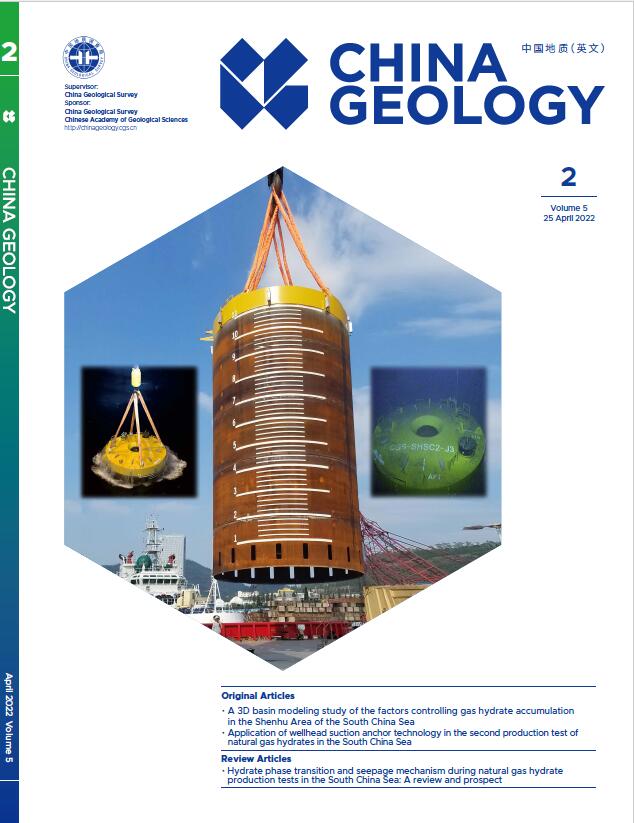



 DownLoad:
DownLoad:
